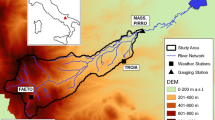Abstract
This paper focuses on consequences of erosion processes on the water quality in a small catchment mainly used for agriculture. Due to the silty soils with small infiltration capacity and some steep slopes, much suspended sediment is carried with the surface runoff into the river. To gain detailed knowledge about the dynamic of suspended particle concentration in the stream, particularly the intensity and the duration of the pollution, continual measurements of turbidity and conductivity have been done. Additionally water samples have been automatically taken regulated by the streamflow and have been analysed in the lab to determine the particle concentration and some dissolved chemical substances such as nitrate and heavy metals. From those measurements a regression between turbidity and suspended particle concentration was derived as basis to calculate suspended load. Results showed a typical hysteresis with bigger particles being transported within the fast rising limb than in the falling limb of the flood waves. Moreover, it was also found, that nitrate concentration was lower during the summer and early autumn than in spring with the same discharge.
Similar content being viewed by others
References
Bechmann M., Deelstra J., Stalnacke P., Eggestad H.O., Ǿygarden L. & Pengerud A. 2008. Monitoring catchment scale agricultural pollution in Norway: policy instruments, implementation of mitigation methods and trends in nutrient and sediment losses. Environ. Sci. Policy 11: 102–114.
Carter J., Owens P.N., Walling D.E. & Leeks G.J.L. 2003. Fingerprinting suspended sediment sources in a large urban river system. Sci. Total Environ. 314–316: 513–534.
Donohue I., Styles D., Coxon C. & Irvine K. 2005. Importance of spatial and temporal patterns for assessment of risk of diffuse nutrient emissions to surface waters J. Hydrol. 304: 183–192.
Gao P., Pasternack G.B., Bali K.M. & Wallender W.W. 2007. Suspended-sediment transport in an intensively cultivated watershed in southeastern California. Catena 69: 239–252.
Jarvie H.P., Haygarth P.M., Neal C., Butler P., Smith B., Naden P.S., Joynes A., Neal M., Wickham H., Armstrong L., Harman S. & Palmer-Felgatea E.J. 2008. Stream water chemistry and quality along an upland-lowland rural land-use continuum, south west England. Characterization and apportionment of nutrient and sediment sources in catchments. J. Hydrol. 350: 215–231.
Lewis J. 1996. Turbidity-Controlled Suspended Sediment Sampling for Runoff-Event Load Estimation. Water Resour. Res. 32: 2299–2310.
Lichner L., Hallett P.D., Feeney D.S., Ďugová, O., Šír M. & Tesař M. 2007. Field measurement of soil water repellency and its impact on water flow under different vegetation. Biologia 62: 537–541.
Pavanelli D. & Bigi A. 2005. A New Indirect Method to estimate Suspended Sediment Concentration in a River Monitoring Programme. Biosyst. Engineer. 92: 513–520.
Peschke G., Etzenberg C., Müller G., Töpfer J. & Zimmermann S. 1997. Problems of regionalization of runoff generation and a possible solution approach, pp. 193–196. In: Diekkrüger B. & Richter O. (eds), Regionalization in Hydrology. Proceed. of Ext. Abstr., Int. Conf. Braunschweig, Landschaftsökologie und Umweltforschung, H. 25.
Pionke H.B., Gburek W.J., Schnabel R.R., Sharpley A.N. & Elwinger G.F. 1999. Seasonal flow, nutrient concentrations and loading patterns in stream flow draining an agricultural hill-land watershed. J. Hydrol. 220: 62–73.
Salvia-Castellví M., Iffly J.F., Borght P.v. & Hoffmann L. 2005. Dissolved and particulate nutrient export from rural catchments: A case study from Luxembourg. Linking Landscape Sources of Phosphorus and Sediment to Ecological Impacts in Surface Waters. Sci. Total Environ. 344: 51–65.
Sebíň M., Pekárová P. & Miklánek P. 2007. Evaluation and indirect estimation of nitrate losses from the agricultural microbasin Rybarik. Biologia 62: 569–572.
Sörme L. & Lagerkvist R. 2002. Sources of heavy metals in urban wastewater in Stockholm. Sci. Total Environ. 298: 31–145.
WFD 2000. Directive 200/60/EC of the European parliament and of the Council of 23 October 2000. Official Journal of the European Communities. L 327.
Author information
Authors and Affiliations
Corresponding author
Rights and permissions
About this article
Cite this article
Kändler, M., Seidler, C. Erosion processes alter water quality in a stream within a small catchment in the Upper Lusatia Region in Saxony. Biologia 64, 546–549 (2009). https://doi.org/10.2478/s11756-009-0070-2
Received:
Accepted:
Published:
Issue Date:
DOI: https://doi.org/10.2478/s11756-009-0070-2




